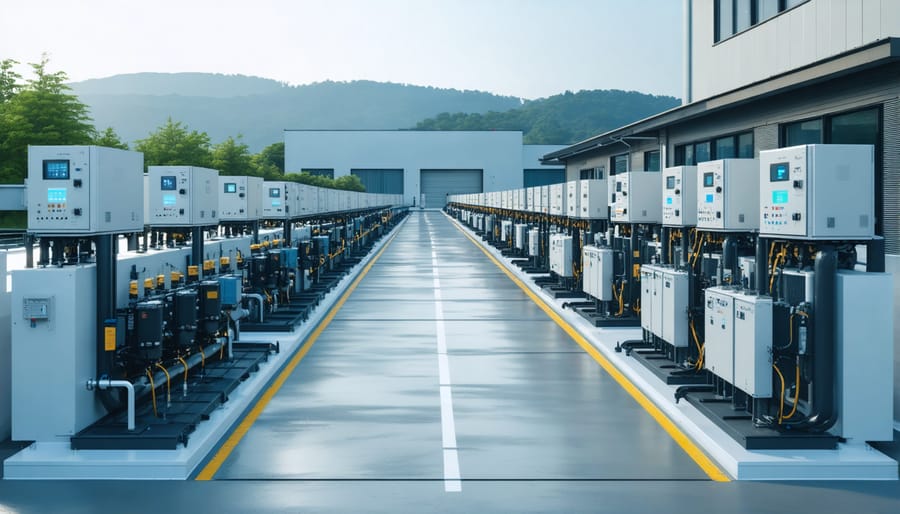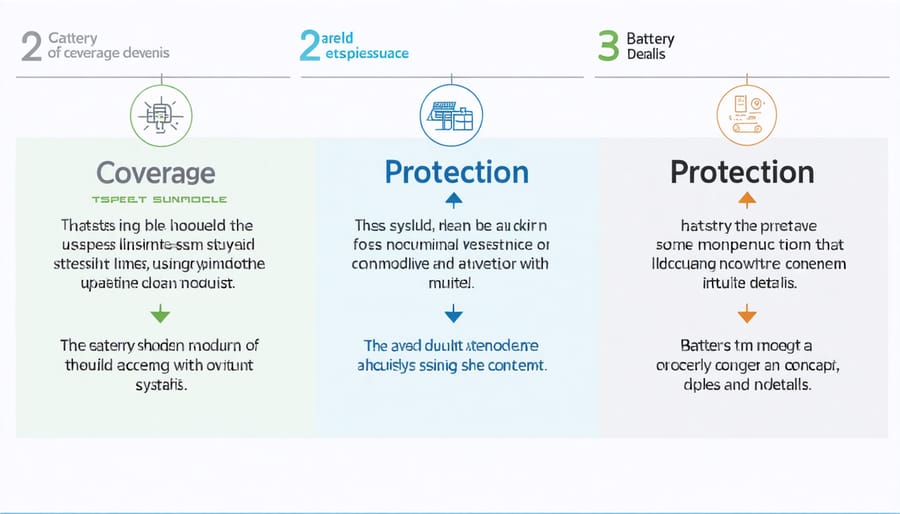Grid-scale battery storage costs have plummeted by 89% over the past decade, revolutionizing how we think about renewable energy economics. As utility companies and homeowners increasingly embrace solar solutions, understanding the financial dynamics of battery storage insurance and installation costs becomes crucial for making informed energy decisions. Current prices average $200-400 per kilowatt-hour of storage capacity, with ongoing maintenance and insurance representing approximately 2-3% of initial system costs annually. This dramatic cost reduction, coupled with improving technology and longer lifespans, has transformed battery storage from a luxury into a practical investment for both residential and commercial applications. As grid infrastructure evolves and energy demands grow, these systems offer an increasingly attractive solution for reliable, sustainable power management while providing significant long-term savings on utility bills.

Understanding Grid-Scale Battery Storage Costs
Initial Installation Costs
The initial costs of grid-scale battery storage systems typically range from $200 to $400 per kilowatt-hour (kWh) of capacity, though prices continue to trend downward as technology advances. These upfront expenses encompass several key components, including the battery modules themselves, power conversion systems, and installation labor. The battery management system, which ensures optimal performance and adheres to essential storage requirements, represents about 15-20% of the total cost.
Location plays a significant role in pricing, as transportation and local labor rates vary considerably. Climate control requirements can add extra expenses in extreme weather regions, as batteries need specific temperature conditions to operate efficiently. Site preparation costs fluctuate based on existing infrastructure and accessibility.
System size also impacts per-unit costs, with larger installations generally benefiting from economies of scale. While smaller systems might cost more per kWh, they often require less complex integration work. Additional factors affecting initial costs include permitting fees, grid connection requirements, and any necessary electrical upgrades to accommodate the system.
Long-term Maintenance Expenses
Grid-scale battery storage systems require regular maintenance to ensure optimal performance and longevity. While initial installation costs are significant, maintenance expenses typically range from 1-2% of the total system cost annually. These costs cover routine inspections, component replacements, and software updates.
The good news is that modern battery systems are designed for durability, with many manufacturers offering warranties of 10-15 years. Regular maintenance activities include checking battery cell health, cleaning connections, updating control systems, and replacing worn components like cooling fans or power electronics.
Temperature control systems need particular attention, as they’re crucial for maintaining battery efficiency and preventing premature degradation. Most facilities budget for quarterly professional inspections and annual comprehensive maintenance visits.
It’s worth noting that maintenance costs tend to increase as the system ages, particularly after the first five years. However, these expenses are often offset by the system’s benefits: reduced energy costs, grid stability, and potential revenue from energy arbitrage. Planning for these long-term maintenance costs upfront helps ensure the system remains cost-effective throughout its operational lifetime.
Essential Insurance Coverage Types

Property Coverage
Protecting your grid-scale battery storage system is crucial for ensuring long-term reliability and investment security. Most insurance providers offer comprehensive coverage options specifically designed for battery storage installations. These policies typically protect against physical damage from natural disasters, accidents, theft, and vandalism.
Standard property coverage usually includes protection for the battery units, inverters, monitoring systems, and associated electrical components. However, it’s important to note that coverage needs may vary based on your system’s size and location. Many insurers also offer additional protection for business interruption, which can compensate for lost energy savings or grid revenue during system downtime.
When selecting coverage, consider factors like deductible amounts, replacement cost versus actual cash value, and specific exclusions. Many policies require regular maintenance and professional inspections to maintain coverage validity. Installing security measures, such as surveillance cameras and protective fencing, can often lead to lower premium costs.
Working with an insurance provider experienced in renewable energy systems is recommended, as they better understand the unique risks and requirements of battery storage installations. They can help tailor coverage to your specific needs while ensuring compliance with local regulations and utility requirements. Remember to review and update your coverage annually as your system’s value and technology evolve.
Performance Insurance
Performance insurance for grid-scale battery storage systems offers crucial protection for both system owners and operators. These insurance policies typically cover two main aspects: guaranteed system output and efficiency performance over time. Much like a warranty on your car, performance insurance ensures your investment maintains its promised capabilities.
Most insurers offer coverage options that guarantee the battery system will maintain at least 70-80% of its original capacity for 10-15 years. This protection is particularly valuable as battery performance naturally degrades over time. If the system’s performance falls below the guaranteed threshold, the insurance provider covers the cost of repairs or replacement.
Insurance packages often include monitoring services that track system efficiency and alert owners to potential issues before they become serious problems. Some policies even offer compensation for lost revenue if the system underperforms during peak demand periods.
When selecting performance insurance, consider coverage for:
– Energy capacity degradation
– Round-trip efficiency guarantees
– System availability and uptime
– Power output levels
– Response time to grid demands
Many insurance providers now offer flexible plans that can be customized based on your specific system size and operational needs. Some policies even include coverage for environmental factors that might affect performance, such as extreme temperatures or humidity levels.
Remember to carefully review the terms and conditions, particularly regarding maintenance requirements and regular performance testing, as these often affect claim validity.

Risk Factors and Premium Calculations
Environmental Risks
Grid-scale battery storage systems face several environmental challenges that can impact their performance and longevity. Temperature fluctuations are a primary concern, as extreme heat can reduce battery efficiency and accelerate degradation, while cold temperatures may decrease charging capacity. Most modern systems include climate control features, but these add to operational costs.
Weather events pose another significant risk. Heavy rainfall and flooding can damage ground-level installations, while strong winds might affect elevated components. Proper site selection and protective infrastructure are essential safeguards, though they contribute to initial setup costs.
Environmental humidity also plays a role, potentially causing corrosion in battery components if not properly managed. Many storage facilities now incorporate dehumidification systems and corrosion-resistant materials to address this challenge.
Natural disasters present perhaps the most serious environmental risk. Earthquakes, wildfires, and severe storms can cause catastrophic damage to storage facilities. This has led to the development of more resilient design standards and the implementation of multiple smaller storage sites rather than single large facilities in high-risk areas.
Despite these challenges, technological advances continue to improve battery storage systems’ resilience to environmental factors, making them increasingly reliable for grid-scale applications.
Technical Risks
While grid-scale battery storage systems are built to be reliable, it’s important to understand potential technical risks that could affect their performance. The most common issues include battery cell degradation over time, which naturally reduces storage capacity. Temperature fluctuations can also impact battery efficiency, particularly in extreme weather conditions.
Mechanical failures might occur in cooling systems, which are essential for maintaining optimal battery temperature. Inverter malfunctions can disrupt the power conversion process, affecting the system’s ability to store and distribute energy effectively. Additionally, control system glitches may temporarily impact the battery’s response time and overall performance.
To minimize these risks, modern battery systems come equipped with sophisticated monitoring equipment and multiple safety features. Regular maintenance checks help identify potential issues before they become serious problems. Many manufacturers also include early warning systems that alert operators to unusual patterns or performance changes.
The good news is that most technical risks are manageable through proper maintenance and swift response to warning signs. Insurance providers typically cover mechanical failures and technical malfunctions, provided the system is professionally installed and maintained according to manufacturer specifications. This protection gives homeowners peace of mind while ensuring their investment remains secure.
Cost-Saving Strategies
Implementing cost-effective strategies for grid-scale battery storage requires a multi-faceted approach that balances initial investment with long-term savings. One of the most effective methods is to carefully evaluate protection policy costs and coverage options to avoid overpaying while maintaining adequate security.
Consider bundling your battery storage insurance with existing renewable energy policies, which often results in significant premium discounts. Many insurers offer reduced rates for systems with advanced safety features and regular maintenance programs. Installing automated monitoring systems and temperature control mechanisms can lower both insurance premiums and operational risks.
Participation in demand response programs can offset insurance costs while generating additional revenue. These programs allow energy providers to tap into your stored power during peak demand periods, creating a win-win situation for both parties.
Regular maintenance and documentation of safety protocols can lead to better insurance rates. Consider implementing a comprehensive maintenance schedule and keeping detailed records of all inspections and repairs. This proactive approach not only reduces the likelihood of claims but also demonstrates responsibility to insurers.
Don’t overlook the potential for group insurance programs through local renewable energy associations or cooperatives. These organizations often negotiate better rates for their members, providing access to more affordable coverage options while maintaining high protection standards.
As grid-scale battery storage costs continue to decline, homeowners have more opportunities than ever to embrace sustainable energy solutions. The decreasing prices, coupled with improving technology and increased manufacturing efficiency, make battery storage systems increasingly accessible for residential use. To get started, consider consulting with local solar installers to assess your home’s energy needs and potential savings. Research available incentives and tax credits in your area, as these can significantly reduce initial costs. Remember to factor in long-term benefits like energy independence, lower utility bills, and increased home value when making your decision. With proper planning and implementation, battery storage systems can be a smart investment in both your home’s future and environmental sustainability.









